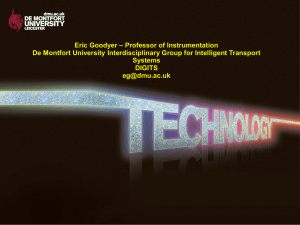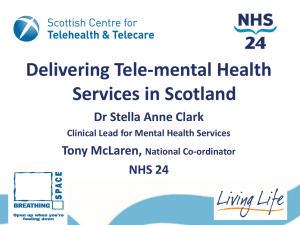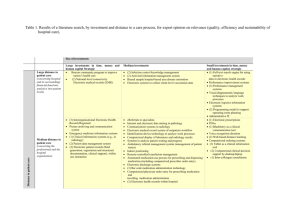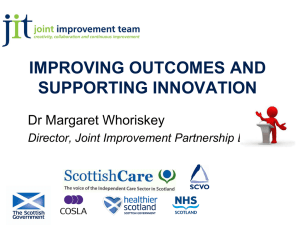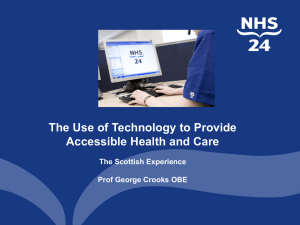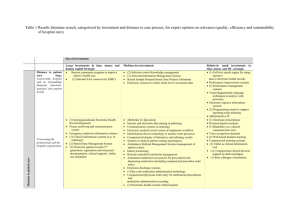Assistive Technology Meeting 20 January 2010 (doc
advertisement
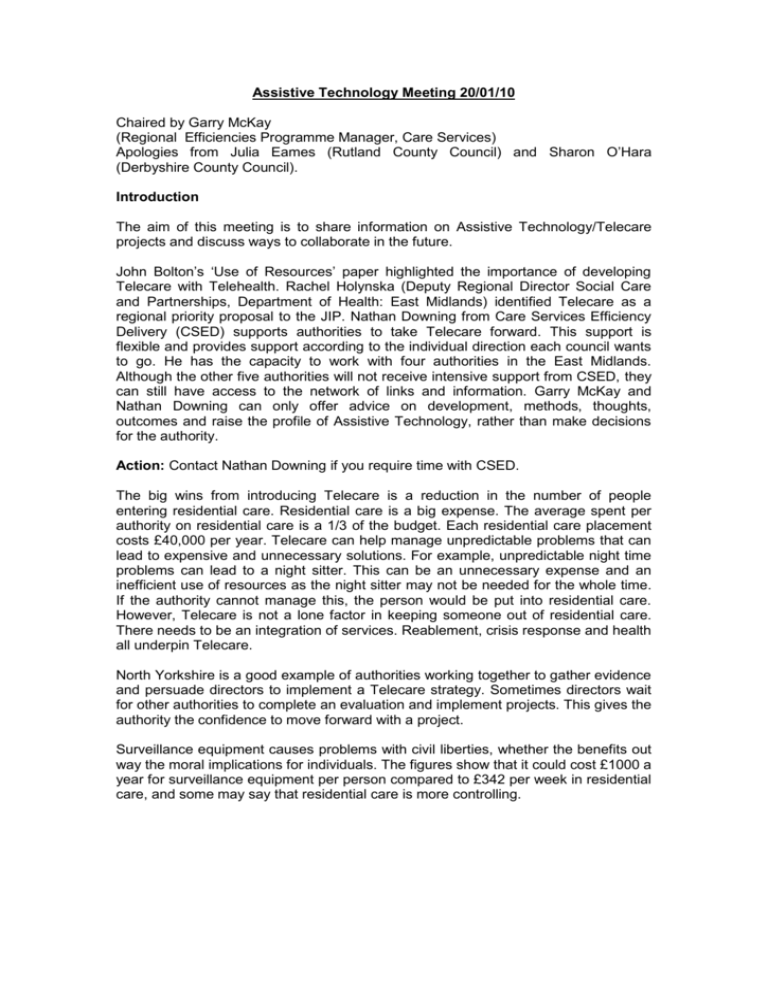
Assistive Technology Meeting 20/01/10 Chaired by Garry McKay (Regional Efficiencies Programme Manager, Care Services) Apologies from Julia Eames (Rutland County Council) and Sharon O’Hara (Derbyshire County Council). Introduction The aim of this meeting is to share information on Assistive Technology/Telecare projects and discuss ways to collaborate in the future. John Bolton’s ‘Use of Resources’ paper highlighted the importance of developing Telecare with Telehealth. Rachel Holynska (Deputy Regional Director Social Care and Partnerships, Department of Health: East Midlands) identified Telecare as a regional priority proposal to the JIP. Nathan Downing from Care Services Efficiency Delivery (CSED) supports authorities to take Telecare forward. This support is flexible and provides support according to the individual direction each council wants to go. He has the capacity to work with four authorities in the East Midlands. Although the other five authorities will not receive intensive support from CSED, they can still have access to the network of links and information. Garry McKay and Nathan Downing can only offer advice on development, methods, thoughts, outcomes and raise the profile of Assistive Technology, rather than make decisions for the authority. Action: Contact Nathan Downing if you require time with CSED. The big wins from introducing Telecare is a reduction in the number of people entering residential care. Residential care is a big expense. The average spent per authority on residential care is a 1/3 of the budget. Each residential care placement costs £40,000 per year. Telecare can help manage unpredictable problems that can lead to expensive and unnecessary solutions. For example, unpredictable night time problems can lead to a night sitter. This can be an unnecessary expense and an inefficient use of resources as the night sitter may not be needed for the whole time. If the authority cannot manage this, the person would be put into residential care. However, Telecare is not a lone factor in keeping someone out of residential care. There needs to be an integration of services. Reablement, crisis response and health all underpin Telecare. North Yorkshire is a good example of authorities working together to gather evidence and persuade directors to implement a Telecare strategy. Sometimes directors wait for other authorities to complete an evaluation and implement projects. This gives the authority the confidence to move forward with a project. Surveillance equipment causes problems with civil liberties, whether the benefits out way the moral implications for individuals. The figures show that it could cost £1000 a year for surveillance equipment per person compared to £342 per week in residential care, and some may say that residential care is more controlling. Telecare Service Leicestershire County Council is currently developing a Telecare strategy and a steering group. The Telecare profile has been raised and is moving out from the Supporting People Strategy. A joint strategy between Telecare and Telehealth is a work in progress. The community alarm service is being reviewed and will be complete by end of 2010, tendered to 2011. They are looking at a single community alarm centre. Nottingham City Council has an integrated Telehealth - Telecare service with Sally Parker (NHS Nottingham City Telehealth Project Manager). There is no strategy, just a formal project that started with no strategy. There is new money for standalone Telecare with the PCT. Eventually all will be the Assistive Technology service. There is buy-in. ¼ million pounds in Telecare a year ago and ¼ million pounds in standalone was received from Health. There is no strategy and no guarantee from April 1st to pay for Telehealth. Last year Telecare had an ongoing commitment but ¼ million pounds it is not enough. This year there will be £100,000 grant in March. There is no structure of ongoing staff. One call centre committed to pay the charge if there is enough calls coming through. A specialist response call centre is wanted. SMART clinics work but there may be a problem if the call centres are regionalised. Leicester City Council has a Telecare plan. In March 2009 the strategy was updated and is stand alone. Assistive Technology strategy is not part of Telecare. It is getting worked into other strategies like Housing. Potentially there will be no need for a review as it will be part of services across care. Funding is mainstreamed and response team is mainstreamed. Getting the PCT involved is the biggest concern. Lincolnshire County Council has an evaluation document complete. They will be looking at a strategy and have strategy board meeting with other organisations with various commitments from health. A plan is starting to form; it is a work in progress. There are figures projected for the next year and the year ahead. Next year health is coming in. They are giving funds to Health and Wellbeing rather than to Telecare. The funds will have to be found internally. Nottinghamshire County Council has an issue with the current strategy because there has been a refocus of financial priorities due to the change in management (two tier authorities have these problems). Telecare is an underdeveloped area and there needs to be a partnership developed with principle providers. There was an original Telecare strategy and assistive technology strategy. Now there is a shift towards concrete evidence. There is a joint commissioning strategy with PCT but Telehealth has not progressed further even after meetings. Funding is a major issue as there needs to be a degree of certainty and a three years guarantee. As funding could disappear there is no incentive to move Telecare forward. Community Alarm projects have been moved to private sectors. A single monitoring centre has been established but finances result in higher costs than obtainable in the private market. Northamptonshire County Council has an overview of Telecare strategy. There is a strategy and Project Initiation Document (PID) for the next three years. This is imbedded in prevention and intervention. The biggest challenge is the funding process and involvement of the PCT. There needs to be funding from other streams and tangible evaluations instead of theories. Funding is needed to allow the vision of Telecare that is there to be implemented. Currently the only money available is for staff and is from savings yet to be made. There is a forecast for a change in administration and the charging element is unclear (is there a charging element on equipment?). This issue has gone out to consultation. Derby City Council has no growth or decline in Telecare. The strategy has not changed from the start when it was grant funded even though now it is mainstreamed. Health is a barrier as they are sceptical about the cost savings. This scepticism comes from the lack of evidence to show that Telecare saves an effective amount of money. It is always said that the money saved is not down to Telecare alone. There is a limited strategy to seek funding but primarily the current Telecare strategy is not fit for purpose, it is more of a commissioning strategy than anything else. The funding currently available is fine, it is the vision and a better use of resources that is required to move things forward. Topics Discussed Health Partnership: There needs to be a joint development strategy for crisis response, medication management and the measurement of respective benefit in Telecare. Medication Management: Leicester City Council highlights one of the problems medication management presents. Pharmacists are on board with the project and Boots charge £20. However 50% of service users do not have to pay for their service package, which makes this project unaffordable. Action: A medication management business case is needed, Worcester Council may have one. This can be lifted and replicated across the region with TASS funding or REIP funding. Community Alarm Services: Shires have a problem as there are multiple partnerships to deal with in the region. There is a possibility of outsourcing response services. A monitoring centre can be anywhere. The costs will be different if bring together councils, but this is difficult. Leicestershire have a contract under review and out to tender until next year. Nottingham City Council have no contract just a service level agreement. Lincolnshire County Council has no information. Nottinghamshire County Council are waiting for the Supporting People project to decide. Northamptonshire County Council: Tender for a full social response next year. Derby City Council has no contract just a service level agreement. Collecting Evidence: Currently the way evidence is collected in each authority is unique. Also, collecting evidence from one supplier does not build a strong case. Sharing information will help build evidence and cases to support the use of Telecare. When collecting evidence to prove the financial savings of Telecare, Telecare data needs to be picked apart from other influences. However, as an example, the evidence currently shows that no one thing can prevent someone entering residential care. It is difficult to cut proportions of efficiencies when all are needed. Also, the benefits of Telecare can be seen in 2 to 3 years time not 1. This makes it difficult to prove efficiencies and savings in one year. Within Leicester City council there was a report to show what would happen in 20 random cases if Telecare was not available. This evaluation compared home care and residential care but the evidence was not considered robust enough and was time consuming. Essex council also completed an evaluation similar to this. The Telecare Service Association (TSA) should help with case study evaluations and searching for evidence to prove Telecare use can create efficiencies. Service groups Dementia and Older People are easy groups to gather evidence and prove that Telecare implementation is good. Other groups aren’t as easy to help and show evidence to support the use of Telecare. Community Care Assessments: Telecare should be the default service and on the frontline but it isn’t always included in the community care assessment across authorities. In Essex, the reablement team knows about Telecare and trains other social care teams to use it. Telecare Strategies: One strategy cannot be used for each authority but sharing strategies can allow an authority to make a personal strategy. Sometimes it will not be possible to find a strategy as an authority went forward without one. Monitoring Centres: Monitoring centres can technically be anywhere. Councils could join together in one centre but a larger workload may cause other problems. Local monitoring centres provide a more personal service. A professional approach, such as the Tunstall centres are driven by the number of calls answered and do not provide a good service. They are scripted and some say uncaring. This shows that outsourcing can be expensive if care is to be valued as well as cost. The question is whether the premium charge for local service compared to outsourcing is made up by the quality of care and efficiency this service provides. A clinical approach may not keep people at home but a local response service must work well to send people in the right direction for help. There is a national provider that wants to provide monitoring centres across the country and is going into home care business. Nottinghamshire County Council has found that inexperienced staff results in higher costs because expensive services are requested when they are not always necessary. Faults may not be rectified quickly and cheaply, which leads to expense and a reduction in service quality. Summary and Actions There are examples of the strategy some national/senior authorities used to mainstream Telecare and put it at the front of services. There are some practical issues regarding Telecare such as: 1. Charging policies; there are 130 charging policies already online available 2. Equipment; provided by different suppliers and the only information is from the biased salesperson. Users should share information on the best practice 3. Decommissioning and refurbishment; how should this be done? Pay external? How much? All these issues present the question, what is the best mechanism to share information? Equipment Directory: This should be like a review page where people can feedback about products used. Most people have said they only have time to answer queries if they come directly to their accounts rather than logging onto a separate forum. The most efficient method would allow queries to be sent out to everyone and answers archived to prevent people repeating questions. This distribution network will only work with a small number of people. Information for collection and distribution: Telecare strategies – helpful for authorities to see a direction to the service and highlights communal themes Evaluations and appraisals of Telecare Service Medication management policies Charging policies Good case studies Action: Develop a mechanism to share experiences and post questions to problems. Action: Agree to a common approach for data collection so it is possible to compare information between authorities. Nathan Downing could speak to a data analysis (Kim) Action: Discuss Personalisation at future meetings Action: Garry to bring up issues at the next JIP meeting and share information from Matt Bowsher with everyone Next Meeting: in 3 months, week commencing 12th April. Date to be confirmed.
